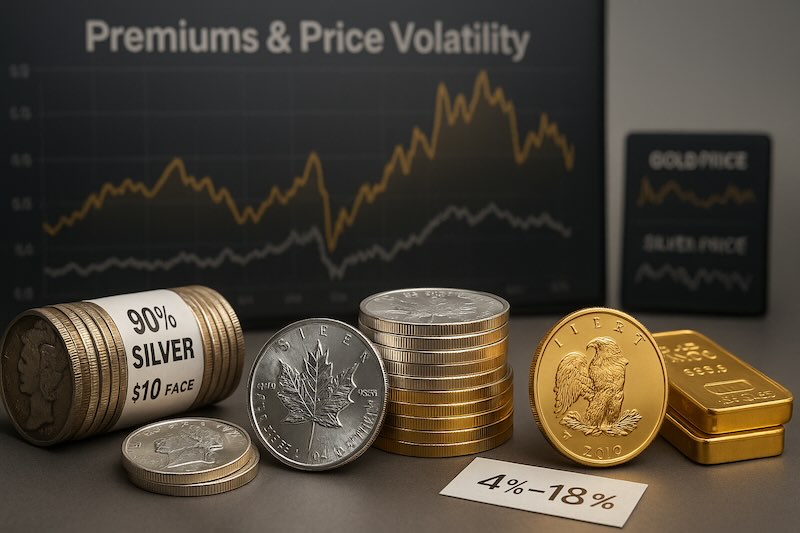Precious-metals markets have experienced a sharp rally to record nominal highs followed by an abrupt pullback. That volatility is showing up not only in futures and ETF flows but also in the real-world costs of buying and selling physical metal: dealer premiums, buy-back bids, and availability have widened and, in some cases, inverted.
Retail buyers should treat today’s market as one of fractured liquidity. Opportunities exist (low premiums on some vintage gold and junk-silver deals), but so do execution and counterparty risks. This article explains why, cites industry evidence, and outlines prudent positioning over the next 6–12 months.
From record highs to a sudden retraction: what happened
In 2025, both gold and silver rallied strongly, driven by a combination of macro uncertainty, institutional accumulation, and speculative flows. Gold reached successive nominal records, and silver staged a rapid advance that briefly revisited levels not seen in decades.
Much of the run was underpinned by: (a) expectations for central-bank reserve accumulation and a softer dollar; (b) growing geopolitical risk premia; and (c) sizable investor inflows into ETFs and physical product.
The market then experienced a sharp retracement: gold recorded its most significant one-day dollar decline in over a decade, and silver fell more than single-day historical norms. A mix of profit-taking, options unwind, and a short-term recalibration around macro prints caused the swift pullback. Several major houses characterized the correction as a consolidation rather than a trend reversal, but the intraday moves exposed acute liquidity mismatches between paper and physical markets.
Why are price swings now affecting dealer premiums and physical liquidity
There are three interlocking mechanisms by which volatility transmits into premiums and buy-back bids:
A. Refining and processing stress (the “silver freeze”). A sudden surge of scrap and lower-purity silver into the system, together with sharply higher lease/financing costs for physical metal, has led some refiners to restrict intake or temporarily pause acceptance of junk and sterling scrap.
That break in the processing pipeline reduces the practical supply of refined product, causing buy-backs to drop and dealer spreads to widen for fractional physical product. The dynamics are visible in recent reporting on refinery bottlenecks and junk-silver illiquidity.
B. Inventory and working-capital constraints at dealers. Dealers manage finite working capital and balance-sheet exposure; when volatility rises, many respond by hoarding liquid, saleable stock and limiting buybacks to preserve inventory. That makes it harder for retail sellers to realize spot-like prices even when the nominal spot is high. Market listings and price-comparison aggregators show active spot and below-spot promotions for specific packaged inventory (starter packs, junk-silver rolls) while simultaneously showing depressed buy-back quotes for scattered lots of circulated coinage.
C. Repricing across product types. Not all physical products behave the same. Modern, current-year bullion coins (new-mint ASEs, Eagles, Buffalos) are increasingly subject to supply-chain frictions and elevated premiums; by contrast, some secondary-market categories, including pre-1933 U.S. gold, random year proof or low-demand numismatic items, are currently being offered at historically compressed premiums or even near melt value as dealers reprice inventory and chase liquidity. Evidence of proof-finish American Gold Eagles trading relatively cheaply in wholesale channels illustrates how demand has bifurcated across product lines.
How this shows up for buyers and sellers

- Junk silver: Several online dealers are advertising silver-at-spot starter deals and limited below-spot promotions to acquire retail demand or rotate inventory. Those offers, however, do not imply a universal bid at the same level. Due to refinery restrictions, most dealers are selectively buying bagged or roll quantities while restricting ad hoc walk-in buy-backs. Buy-back spreads and premiums for 90% silver coins are at their lowest levels in years.
- Pre-1933 gold: Several sellers are listing vintage U.S. gold coins at compressed premiums; some circulated pieces can trade very near melt when dealer appetite for quick inventory turnover is high. Tools and calculators from major dealers and grading services make it straightforward to check melt benchmarks. That said, condition, provenance, and certification still matter. Rare dates remain numismatically bid.
- Proof and numismatic pieces: Recent reporting indicates that proof Gold American Eagles are trading wholesale at bids below the price of some bullion strikes, an unusual inversion that reflects uneven retail demand and high turnover in bullion channels. For collectors, this can create arbitrage opportunities, but it also signals transient dislocation that could reverse.
- Modern one-ounce bullion: Premiums on freshly minted 1-oz Eagles and Buffalos have widened in many channels as mint allocations, shipping, and dealer hedging costs reprice. Comparisons across dealer quotes show a band roughly in the low single digits to high teens percentage over spot, depending on coin, fractional size, and dealer markup.
Forecasts & scenarios for the next 6–12 months
Rather than a single point forecast, treat the next 6–12 months as three plausible scenarios:
Base case (highest probability): Consolidation near current levels with periodic retests. Gold and silver trade in a wider but bounded range as central bank purchases and structural investment demand remain supportive, while intermittent risk-on episodes and supply responses check parabolic moves. Dealer premiums normalize gradually as refiners clear backlogs and lease rates settle. Institutional forecasts from major banks support a higher mid-term range for gold.
Bull case (conditional): Renewed policy dovishness, a weaker dollar, and a supply shock (mine outage or further refinery constraints) push precious metals materially higher. Bull-case targets for gold in some institutional notes remain well above current levels, which would keep physical demand and spot premiums elevated.
Bear/consolidation case: If macro data surprises to the upside, the dollar strengthens and real yields rise, both metals could correct into a lower trading range; dealer inventories would build, and premiums—especially on modern newly minted coins—would compress again as supply stabilizes.
Practical positioning: scale into exposure; stagger purchases across short (weeks), medium (months), and long (12+ months) horizons; prioritize product liquidity (recognizable government bullion, standard fractional sizes) unless you have numismatic expertise; and maintain cash for opportunistic buys on transient pullbacks.

How to navigate premium volatility
- Compare live quotes before every trade. Compare multiple reputable dealers for both buy and sell prices.
- Understand buy-back terms. Many “at-spot” offers are promotional or inventory-specific; check whether the dealer will repurchase at that price.
- Favor a fungible, recognizable product for liquidity. When liquidity matters, standard government coins (1-oz Eagles, Maple Leafs, Philharmonics) typically trade easier than generic rounds or odd fractional proof issues.
- Consider junk silver as a tactical allocation—but be mindful of current refining constraints. Junk silver can be bought at attractive effective prices in promotions, but realize the current “silver freeze” can complicate wholesale buy-backs.
- Use professional storage for larger holdings. When premiums and volatility create execution risk, vaulted insured storage reduces custody friction for large positions.
Final thoughts
Precious metals markets are influenced by macro policy, geopolitical events, technical positioning, and operational constraints such as refining, shipping, and insurance, all of which can change quickly. Before making material purchases or sales, consult a qualified financial advisor and verify dealer terms and live prices.
Volatility has returned as a feature rather than an aberration in 2025’s precious metals markets. That is inconvenient for short-term traders but constructive for investors who can apply a disciplined, cash-ready approach: scale in, choose a liquid product, and verify counterparty execution. The current market dislocations are temporary, but they underscore an enduring truth: in physical markets, convertibility and counterparty capacity matter as much as the quoted spot price.
This article is educational only and does not constitute individualized investment advice.






